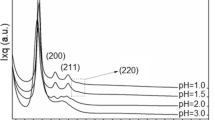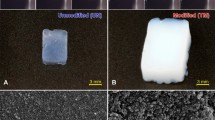Abstract
Structural rearrangement of sol–gel-derived silica gel by aging under basic conditions was investigated using small angle X-ray scattering (SAXS) and 29Si nuclear magnetic resonance (NMR). A wet silica gel prepared under acidic conditions had a fractal nature, and many unreacted silanols remained on the surface. During aging of the gel in ammonia solution, additional Si—O—Si bonds rapidly formed, whereas the change in mesoscale structure gradually proceeded. This result was compared with that of simulation modeling the Ostwald ripening, i.e. dissolution from positive curvature and reprecipitation on negative curvature. In the simulation, structural change in a cluster from fractal nature to particle aggregates was well visualized in 2-dimmensional square lattice. Both scattering profiles calculated from the model clusters and the change in average coordination number of monomers in the cluster well agreed with the experimental SAXS and NMR results, respectively. This agreement strongly ensures us that structural change by aging under basic conditions proceeds through the Ostwald ripening. The mesopore size as well as mesopore volume in calcined silica gel is determined by the shrinkage degree during drying and calcination. The sample aged in basic solution restrains the shrinkage because of the growth of particulate structure, and retains large size and volume of pores.
Similar content being viewed by others
References
W.G. Fahrenholtz, D.M. Smith, and D.W. Hua, J. Non-Cryst. Solids 144, 45 (1992).
W.G. Fahrenholtz and D.M. Smith, Mat. Res. Soc. Symp. Proc. 271, 705 (1992).
L. Chu, M.I.T.-Tejedor, and M.A. Anderson, Mat. Res. Soc. Symp. Proc. 346, 855 (1994).
Y. Lu, G.Z. Cao, P.P. Kale, L. Delattre, C.J. Brinker, and G.P. Lopez, Mat. Res. Soc. Symp. Proc. 435, 271 (1996).
M. Toba, S. Niwa, K. Shimizu, and F. Mizukami, Nippon Kagaku Kaishi 1989, 1523 (1989).
M. Toba, F. Mizukami, S. Niwa, and K. Maeda, J. Chem. Soc., Chem. Commun. 1990, 1211 (1990).
T. Yazawa, A. Miyake, and H. Tanaka, J. Ceram. Soc. Japan 99, 1094 (1991).
R. Takahashi, S. Sato, T. Sodesawa, M. Suzuki, and K. Ogura, Bull. Chem. Soc. Jpn. 73, 765 (2000).
H. Izutsu, F. Mizukami, T. Sashida, K. Maeda, Y. Koizumi, and Y. Akiyama, J. Non-Cryst. Solids 212, 40 (1997).
R. Takahashi, S. Sato, T. Sodesawa, and M. Kawakita, Chem. Lett. 1999, 1107 (1999).
R. Takahashi, S. Sato, T. Sodesawa, M. Kawakita, and K. Ogura, J. Phys. Chem. B 104, 12184 (2000).
C.T. Kresge, M.E. Leonowicz, W.J. Roth, J.C. Vartuli, and J.S. Beck, Nature 359, 710 (1992).
J.S. Beck, J.C. Vartuli, W.J. Roth, M.E. Leonowicz, C.T. Kresge, K.D. Schmitt, C.T. Chu, D.H. Olson, E.W. Sheppard, S.B. McCullen, J.B. Higgins, and J.L. Schlenker, J. Am. Chem. Soc. 114, 10834 (1992).
S. Inagaki, Y. Fukushima, and K. Kuroda, J. Chem. Soc., Chem. Commun. 1993, 680 (1993).
S. Inagaki, A. Koiwai, N. Suzuki, Y. Fukushima, and K. Kuroda, Bull. Chem. Soc. Jpn. 69, 1449 (1996).
P. Yang, D. Zhao, D. Margolese, B. Chmelka, and G. Stucky, Nature 396, 152 (1998).
H. Minakuchi, K. Nakanishi, N. Soga, N. Ishizuka, and N. Tanaka, Anal. Chem. 68, 3498 (1996).
K. Nakanishi, J. Porous Mater. 4, 67 (1997).
K. Nakanishi, R. Takahashi, T. Nagakane, K. Kitayama, N. Koheya, H. Shikata, and N. Soga, J. Sol–Gel Sci. Technol. 17, 191 (2000).
K. Nakanishi, H. Shikata, N. Ishizuka, N. Koheya, and N. Soga, J. High Res. Chromatogra. 23, 106 (2000).
R. Takahashi, S. Sato, T. Sodesawa, N. Nakamura, S. Tomiyama, T. Kosugi, and S. Yoshida, J. Nanosci. Nanotechnol. 1, 169 (2001).
S. Tomiyama, R. Takahashi, S. Sato, T. Sodesawa, and S. Yoshida, Appl. Catal. A General 241, 349 (2003).
R. Takahashi, K. Nakanishi, and N. Soga, Faraday Discuss. 101, 249 (1995).
C. Brinker and J. Scherer, Sol–gel Science, The Physics and Chemistry of Sol–Gel Processing (Academic Press, New York, 1990) Chap. 3 and 5.
R. Takahashi, K. Nakanishi, and N. Soga, J. Sol–Gel Sci. Technol. 17, 7 (2000).
R. Takahashi, K. Nakanishi, and N. Soga, J. Non-Cryst. Solids 189, 66 (1995).
R. Takahashi, S. Takenaka, S. Sato, T. Sodesawa, K. Ogura, and K. Nakanishi, J. Chem. Soc., Faraday Trans. 94, 3161 (1998).
Author information
Authors and Affiliations
Corresponding author
Rights and permissions
About this article
Cite this article
Takahashi, R., Nakanishi, K. & Soga, N. Insight on Structural Change in Sol–Gel-Derived Silica Gel with Aging under Basic Conditions for Mesopore Control. J Sol-Gel Sci Technol 33, 159–167 (2005). https://doi.org/10.1007/s10971-005-5610-9
Received:
Accepted:
Issue Date:
DOI: https://doi.org/10.1007/s10971-005-5610-9




